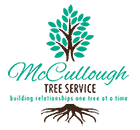By: Shelby McCullough| Published: August 9, 2024
Trees are a vital part of our ecosystem, providing shade, beauty, and oxygen. However, hidden within the seemingly healthy bark of some trees lies a significant risk known as included bark. This blog will uncover the hidden dangers of included bark, why it poses a tree bark risk, and what you can do to mitigate it. Our aim is to educate you on the importance of proper tree care and how to protect your backyard from potential hazards.
What is Included Bark?
Included bark occurs when two or more branches grow so closely together that the bark between them gets trapped inside, forming a weak point in the tree structure. This phenomenon often leads to a higher risk of branch failure because the tree cannot form a proper branch collar, which is essential for supporting the branch’s weight.
The Dangers of Included Bark
1. Structural Weakness:
- Included bark creates a weak point where branches can easily split or break off, especially during storms or high winds.
- Trees with included bark are more likely to suffer from structural failure, which can cause significant damage to property or pose a safety risk to people.
2. Disease and Pest Infestation:
- The trapped bark can create pockets of moisture that attract pests and diseases, further weakening the tree.
- These infestations can spread to other parts of the tree or nearby trees, increasing the overall tree bark risk in your yard.
3. Reduced Tree Health:
- The tree’s inability to form a strong branch union can hinder its growth and overall health.
- Over time, the tree may become more susceptible to other stresses, such as drought or nutrient deficiencies.

Identifying Included Bark
It’s crucial to know how to identify included bark to address it promptly. Here are some signs to look for:
- V-Shaped Crotches: Branch unions with a sharp V shape often indicate included bark, as opposed to the stronger U-shaped unions.
- Cracks and Splits: Visible cracks or splits at the junction of branches can signal included bark.
- Branch Angle: Branches growing at narrow angles are more likely to have included bark.
Steps to Mitigate the Risks
1. Regular Inspections:
- Have a certified arborist inspect your trees regularly to identify and monitor included bark.
- Early detection can prevent major issues and allow for timely intervention.
2. Proper Pruning:
- Prune young trees to encourage strong branch structure and prevent the formation of included bark.
- Remove branches that show signs of included bark before they become a hazard.
3. Cabling and Bracing:
- For mature trees, cabling and bracing can provide additional support to branches with included bark.
- This technique helps stabilize the tree and reduce the risk of branch failure.
4. Tree Removal:
- In severe cases, removing the tree may be necessary to eliminate the risk completely.
- Consult with a professional tree service to assess the situation and determine the best course of action.

Why Choose McCullough Tree Service?
McCullough Tree Service, based in Orlando, Florida, offers a wide range of tree care services, including the management of included bark. Here’s why you should trust them with your tree care needs:
- Certified Arborists: With three ISA-certified arborists on staff, they have the expertise to handle all aspects of tree health and safety.
- Comprehensive Services: From tree removal and trimming to storm damage cleanup, they provide top-notch services to keep your yard safe and beautiful.
- Customer-Focused: As a family-owned business, McCullough Tree Service is dedicated to building strong relationships with their customers and offering affordable, reliable tree care solutions.

The Importance of Professional Tree Care
Attempting to handle tree issues like included bark on your own can be risky and may not address the problem effectively. Professional tree services, like those offered by McCullough Tree Service, ensure:
- Safety: Trained arborists use proper techniques and equipment to handle tree care safely.
- Expertise: Professional assessments provide accurate diagnoses and effective solutions for tree health issues.
- Peace of Mind: Knowing that your trees are in good hands allows you to enjoy your yard without worrying about hidden dangers.
Conclusion
Included bark is a hidden danger that can compromise the safety and health of your trees. By understanding the risks and taking proactive steps, you can protect your backyard from potential hazards. Trusting professionals like McCullough Tree Service ensures your trees receive the best care, maintaining their beauty and safety for years to come.
Contact McCullough Tree Service today for a free estimate and ensure your trees are healthy and safe. Call (407) 734-5854 or visit their website at McCullough Tree Service.

FAQs
What is included bark and why is it a tree bark risk? Included bark is when bark is trapped between two growing branches, creating a weak point. This condition poses a significant tree bark risk due to the increased likelihood of branch failure and pest infestation.
How can I identify included bark in my trees? Look for V-shaped crotches, visible cracks or splits at branch unions, and branches growing at narrow angles.
What should I do if my tree has included bark? Regular inspections, proper pruning, and professional services like cabling and bracing can mitigate the risks. In severe cases, tree removal might be necessary.
Why should I hire a professional tree service? Professional arborists provide safety, expertise, and peace of mind, ensuring your trees are properly cared for and hazards are effectively managed.
How often should I inspect my trees for included bark? Regular inspections, at least once a year, by a certified arborist can help detect and address issues early, preventing major problems.
By following these guidelines and using professional tree care services, you can maintain the health and safety of your backyard, avoiding the hidden dangers of included bark.

